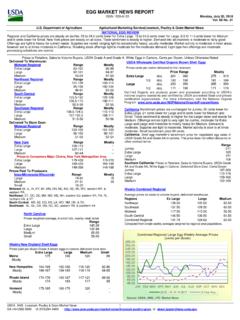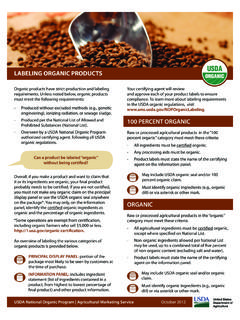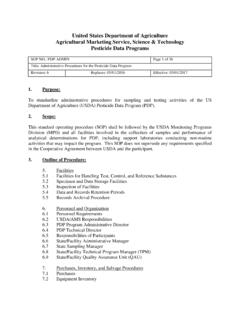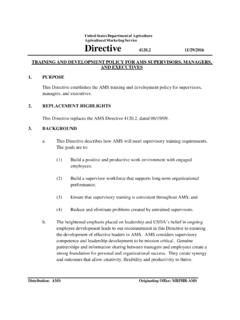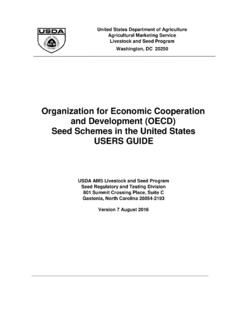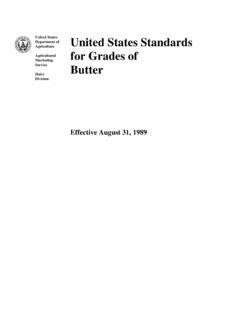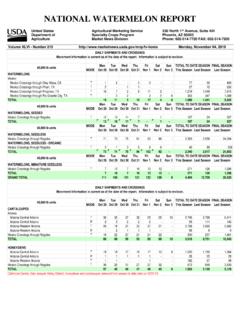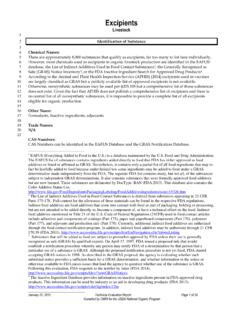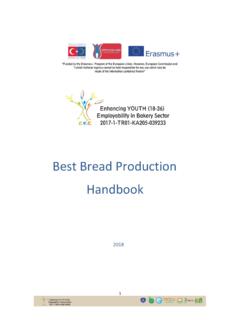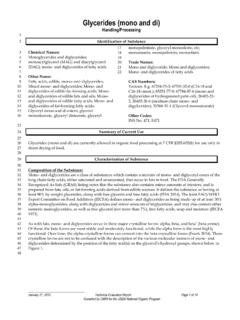Transcription of Cellulose - USDA
1 Cellulose Handling/Processing _____ February 11, 2016 Technical Evaluation Report Page 1 of 12 Compiled by OMRI for the usda National Organic Program 1 Identification of Petitioned Substance 2 Chemical Names: 3 (1 4) linked D-glucose; 4 Polyanhydroglucuronic 5 6 Other Names: 7 Powdered Cellulose ; alpha- Cellulose , flour 8 Cellulose ; Cellulose fibers, paper, linters. 9 Microcrystalline Cellulose , MCC, (derived from 10 Cellulose ) is also called Cellulose gel; Cellulose 11 (Spanish) 12 13 14 15 Trade Names: 16 Alphacel; Arbocel; Avicel; Heweten; JustFiber; 17 QualFlow; Rayophane, Viskase; Vitacel; Vivapur 18 CAS Numbers: 9004-34-6 ( Cellulose powder); 68442-85-3 (regenerated Cellulose ) Other Codes: EINECS 232-674-9 ( Cellulose powder), 270-493-7 (regenerated Cellulose ); SMILES: Cc1ccc(C)c2c1CC(C)C2 19 Summary of Use 20 21 Cellulose is currently allowed under the National Organic Program (NOP) regulations at 7 CFR (b) 22 for use in regenerative casings, as an anti-caking agent, and as a filtering aid.
2 Cellulose is the main 23 component of higher plant cell walls and is also one of the most abundant organic compounds on earth. It 24 can be derived from several sources using a number of techniques that are considered synthetic, and some 25 that might be considered nonsynthetic (natural). Cellulose is available in many forms for different 26 functional purposes in food products. This report considers two forms that are currently permitted for use 27 in organic processing and handling: amorphous powdered Cellulose and inedible Cellulose casing. 28 29 Various forms of Cellulose have many other uses permitted by the FDA, including as a fat substitute and 30 bulking agent in low calorie foods, a texturizer, emulsifier and extender. These uses are not currently 31 permitted under the NOP regulations, and are beyond the scope of this report. Other forms of Cellulose , 32 including microcrystalline Cellulose , nanoparticle Cellulose , and various Cellulose derivatives such as 33 carboxymethylcellulose and Cellulose gums are also beyond the scope of this report.
3 34 35 36 Characterization of Petitioned Substance 37 38 Composition of the Substance: 39 Cellulose is a polysaccharide of the monomer (C6H10O5)n with the glucose units linked by cellobiose 40 (Merck 2015). 41 42 43 Figure 1: Cellulose Monomer (US EPA 2015a) 44 45 Technical Evaluation Report Cellulose Handling/Processing February 11, 2016 Page 2 of 12 In its simplest form, Cellulose is a linear, insoluble polymer of D-glucose units joined by hundreds or 46 thousands of glycosidic linkages, and is considered a polysaccharide. As a polymer, it can take on six 47 different distinct structures, known as polymorphs, and also appears in amorphous forms (O Sullivan 48 1997). Cellulose molecules form long chains in polycrystalline fibrous bundles that contain crystalline as 49 well as amorphous regions. These different forms are able to perform various functions, and not all 50 Cellulose is suitable for every application. 51 52 53 Source or Origin of the Substance: 54 Cellulose is the main structural component of all higher plant cell walls and one of the most abundant 55 organic compounds on earth (EMBL 2015).
4 It is also formed by some algae, fungi, bacteria and marine 56 animals (Whistler and BeMiller 1997; French et al. 1993). 57 58 Most commercial sources of Cellulose are from cotton linters and wood. Most food grade applications 59 require a high degree of purity. Cotton fibers are about 98% Cellulose , while wood is 40-50% Cellulose 60 (Whistler and BeMiller 1997; Ockerman 1991). Linters are the short fibers that remain on cottonseeds after 61 the long fibers used for textile production are removed. Cellulose obtained from cotton linters needs only a 62 treatment with a hot sodium hydroxide solution that removes the protein, pectic substances and wax to 63 produce high quality Cellulose (Whistler and BeMiller 1997). 64 65 Wood requires more extensive processing to solubilize the hemicelluloses and lignins (delignification). The 66 most common manufacturing process is described in Evaluation Question 1. Cellulose can be made as a co-67 product with ethanol from fermented wood (Frederick et al.)
5 2008) and opportunities are growing with the 68 increase in the production of biofuels. 69 70 Cellulose can also be produced from various other plant fibers, such as corn cobs or stalks, soybean hulls, 71 bagasse (sugar cane stalks), oat hulls, rice hulls, wheat straw, sugar beet pulp, bamboo, and fibers such as 72 jute, flax, and ramie among others (Franz and Blaschek 1990; French et al. 1993). 73 74 Recycled paper and cardboard account for a growing source of Cellulose , and 63% of all paper and 75 cardboard generated was recovered for recycling in 2013. This rate of recovery is up from just under 50% in 76 2005 and triple the recovery rate in 1980 (US EPA 2015b). Recycling technologies continue to improve, and 77 the ability to increase recycling recovery and efficiency depends as much on building adequate capacity as 78 it does on the collection of recyclable material (Roberts 2007). 79 80 For economic reasons, different sources of Cellulose are used for different purposes.
6 Pulp and paper are 81 usually produced from wood, while textile fibers are generally not isolated from woody fibers. Cotton 82 fibers are a biological source of almost pure Cellulose , but this is not usually used in food grade Cellulose . 83 Cotton fibers are used instead for various Cellulose derivatives for pharmaceutical or chemical engineering 84 uses, such as chromatography, paints, and explosives (Franz and Blaschek 1990). 85 86 Cellulose technology continues to evolve. Microbially produced Cellulose can be made from fermentation 87 of sugars with bacteria or microalgae. Bacterial sources of Cellulose have also been developed using 88 Acetobacter xylinum that ferments substrates of glucose from corn syrup (French et al. 1993; Delmer and 89 Amor 1995). 90 91 Cellulose is also currently the subject of research and development in nanotechnology. Cellulosic 92 nanocrystals have a number of physical and chemical characteristics that go beyond microcrystalline 93 Cellulose in terms of strength, directionality for making structured composites, and hydrophilic / 94 hydrophobic capacity (Hubbe et al.)
7 2008). Cellulose impregnated with nanosilver (Ag NP) has been 95 researched as packaging for meats, although this would not be allowed for use in organic products. The Ag 96 NP migrates into meat, providing preservative properties (Martirosyan and Schneider 2014). 97 98 Technical Evaluation Report Cellulose Handling/Processing February 11, 2016 Page 3 of 12 99 Properties of the Substance: 100 The physical and chemical properties of Cellulose are summarized in Table 1. 101 102 Table 1 : Properties of Cellulose 103 Property Characteristic / Value Source(s) Molecular Formula: (C6H10O5)n (Merck 2015) Molecular Weight: ~162 (monomer); 200-250 (purified cotton); 336,100 (softwood) (Kr ssig 1993; Ellis and Smith 2008) Percent Composition: ~44-45% C, H, 48-49% O (Kr ssig 1993) Physical state at 25 C / 1 Atm. Solid (Merck 2015) Color White (Merck 2015) Odor Odorless (Royal Society of Chemistry 2015) Density / Specific Gravity (Merck 2015) Melting point 360 C (Merck 2015) Boiling point 380 C (Merck 2015) Solubility Insoluble (Merck 2015) Vapor pressure 1 mm Hg @ 714 C (Royal Society of Chemistry 2015) pH (Food Chemicals Codex Committee 2011) Corrosion characteristics Corrosive to metal and tissue (Royal Society of Chemistry 2015) 104 105 Specific Uses of the Substance: 106 The specific uses of Cellulose are summarized in Table 2.
8 107 108 Table 2 : Uses of Cellulose (French et al. 1993; Whistler and BeMiller 1997) 109 Powdered Cellulose Anti-caking agent, used in shredded cheese and spices Filtering aid Moisture retention Non-caloric bulking agent used in reduced calorie products Texturizer, dispersing agent Emulsifier, used in frozen products to maintain texture through freeze - thaw cycles Regenerated Cellulose casing Casing for skinless sausages and hot dogs 110 Uses of powdered Cellulose other than as an anti-caking agent and as a filtering aid are not allowed for 111 organic processed products or organically produced ingredients. Regenerated Cellulose casings may be 112 used for products such as skinless sausages and hot dogs. 113 114 115 Approved Legal Uses of the Substance: 116 Cellulose is approved by the FDA by prior sanction as a food ingredient and additive used before the 117 passage of the 1958 amendments to the Food and Drug Act (Mitchell 1986). Anti-caking agents in grated 118 cheeses are specifically referenced at 21 CFR (b)(4).
9 The uses in Table 2 all appear to be approved. 119 For organic processing and handling, the only uses that are allowed are as a filtering aid, an anti-caking 120 agent, and in regenerative casings in accordance with 7 CFR (b). 121 122 123 Action of the Substance: 124 Cellulose can absorb water, oil, and other liquids, binding 4-9 times its own weight in water (Saltmarsh 125 2000). It is also porous when saturated, permitting liquids to pass while retaining solids. Powdered 126 Cellulose prevents agglomeration of some solids like flour, spices, and shredded cheeses by absorbing, 127 binding and retaining moisture. 128 Technical Evaluation Report Cellulose Handling/Processing February 11, 2016 Page 4 of 12 129 130 Combinations of the Substance: 131 Cellulose takes on many forms and performs a wide range of functions. Food-grade Cellulose filters 132 composed of either 100% or food-grade 99%+ Cellulose without ancillary ingredients are commercially 133 available (ErtelAlsop 2015; Purifiber 2015; International Fiber Corporation 2015).
10 However, the inclusion of 134 other ingredients may reduce labor costs and could increase the functional efficiency of Cellulose for certain 135 processes. Specifically, various polymers and co-polymers can be combined with Cellulose to improve 136 absorption, increase or decrease viscosity, and to increase yield (Adams and Hoftiezer 1968; Lassen 1976; 137 Oechsle, Baur, and Gottkehaskamp 1994). Food grade filtering systems composed mainly of Cellulose may 138 also include various polymers or substances like fiberglass for ease of handling, or to increase throughput 139 (Parker 2008). Silica hydrogels may be combined with Cellulose to increase the removal of proteins and 140 reduce chill hazing of beer (Fernyhough 1994). 141 142 Sometimes preservatives such as natamycin, sorbates or enzymes are added to improve the shelf life of the 143 grated cheeses that use Cellulose as an anti-caking agent (International Fiber Corporation 2015). While 144 natamycin and sorbates would be prohibited under the NOP, enzymes are listed at 7 CFR (a).
